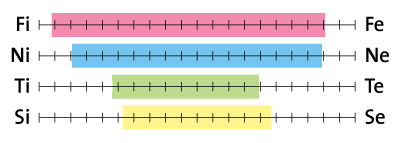VH
Variable Hybrid
- MBTI
- NFJedi
Here's my wacky theory of the day.
I was thinking about this, a bit and I want to run this past you to see what you think about it.
We know that there is a lot of overlap with each function base. For instance, Te and Ti have a fair amount of overlap, as do Fe and Fi, as well as Ne and Ni, and also Se and Si. The descriptions of each of these have to focus on the differences to distinguish them.
That said, I can't help but to consider that these functions aren't as compartmentalized as their descriptions imply. I don't think Fi is Fi, and Fe is Fe, and never the two shall meet. In fact, I think the F function is more of a sliding scale. If a person leans more toward their introverted thought modes, then they'll exhibit more Fi behaviors. The opposite is also true. As a person leans more on their extroverted modes, they'll exhibit more of their Fe traits.
And so on and so forth for the rest of their base functions.
For example...
This is a crude representation of N.
Ni <---|---|---|---> Ne
Let's say a person has a usual peak of N somewhere around here...
Ni <---|X--|---|---> Ne
We'd define that as Ni. However, when that person leans on their extroverted modes, they could move their N to somewhere more like...
Ni <---|---|X--|---> Ne
We'd have to define that as Ne. However, this means that the person has a range of N usage that looks more like this...
Ni <--x|XXX|Xx-|---> Ne
If this is the case, then we've got an entirely new approach to the Jungian functions, and the map of a person's mind might actually look something like this...
Ni <--x|XXX|Xx-|---> Ne
Fi <--x|XXX|XXX|xx-> Fe
Ti <--x|XXX|Xx-|---> Te
Si <---|--x|XXX|x--> Se
I was thinking about this, a bit and I want to run this past you to see what you think about it.
We know that there is a lot of overlap with each function base. For instance, Te and Ti have a fair amount of overlap, as do Fe and Fi, as well as Ne and Ni, and also Se and Si. The descriptions of each of these have to focus on the differences to distinguish them.
That said, I can't help but to consider that these functions aren't as compartmentalized as their descriptions imply. I don't think Fi is Fi, and Fe is Fe, and never the two shall meet. In fact, I think the F function is more of a sliding scale. If a person leans more toward their introverted thought modes, then they'll exhibit more Fi behaviors. The opposite is also true. As a person leans more on their extroverted modes, they'll exhibit more of their Fe traits.
And so on and so forth for the rest of their base functions.
For example...
This is a crude representation of N.
Ni <---|---|---|---> Ne
Let's say a person has a usual peak of N somewhere around here...
Ni <---|X--|---|---> Ne
We'd define that as Ni. However, when that person leans on their extroverted modes, they could move their N to somewhere more like...
Ni <---|---|X--|---> Ne
We'd have to define that as Ne. However, this means that the person has a range of N usage that looks more like this...
Ni <--x|XXX|Xx-|---> Ne
If this is the case, then we've got an entirely new approach to the Jungian functions, and the map of a person's mind might actually look something like this...
Ni <--x|XXX|Xx-|---> Ne
Fi <--x|XXX|XXX|xx-> Fe
Ti <--x|XXX|Xx-|---> Te
Si <---|--x|XXX|x--> Se



